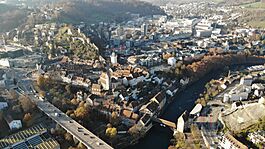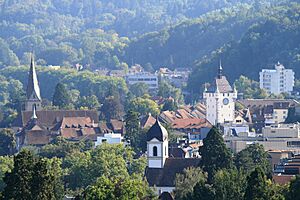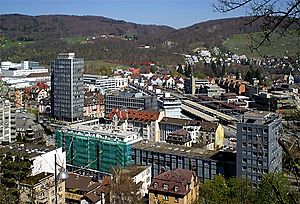Baden, Switzerland facts for kids
Quick facts for kids
Baden
|
||
|---|---|---|
 |
||
|
||
| Country | Switzerland | |
| Canton | Aargau | |
| District | Baden | |
| Area | ||
| • Total | 13.17 km2 (5.08 sq mi) | |
| Elevation | 381 m (1,250 ft) | |
| Population
(Dec 2020 )
|
||
| • Total | 19,621 | |
| • Density | 1,489.8/km2 (3,858.6/sq mi) | |
| Demonym(s) | Badener | |
| Postal code |
5400
|
|
| Surrounded by | Birmenstorf, Ennetbaden, Fislisbach, Gebenstorf, Mellingen, Neuenhof, Obersiggenthal, Turgi, Wettingen | |
| Twin towns | Sighişoara (Romania) | |
Baden is a town in Switzerland, located in the canton of Aargau. Its name means "baths" in German, which makes sense because it's famous for its natural mineral hot springs. These springs have been well-known since the time of the Roman Empire. Baden is about 25 kilometers (15 miles) northwest of Zürich, mostly on the western side of the Limmat River. The main language spoken here is a local Swiss-German dialect. As of 2018, over 19,000 people lived in Baden.
Contents
Geography of Baden
Downtown Baden is on the left side of the Limmat River. The town is divided into different areas like Kappelerhof and Allmend. In 1962, the nearby village of Dättwil became part of Baden. On the other side of the river is Ennetbaden, which used to be called "Little Baden."
Baden covers an area of about 13.17 square kilometers (5.08 square miles). A large part of this land, about 55.8%, is covered by forests. Buildings and roads make up about 33.7% of the area.
The hot sulfur springs that give Baden its name are located north of the downtown area. There are about 20 of these springs, and their water temperatures range from 37 to 52 degrees Celsius (98 to 126 degrees Fahrenheit).
History of Baden
Baden was first known in Roman times as Aquae Helveticae, which means "Waters of the Helvetii" (an ancient Celtic tribe). The Romans loved these natural springs for fun and for their health benefits. A Roman writer named Tacitus described it as a "town... much used for its healthful waters." This Roman settlement was built to support a nearby Roman army camp. It had a large pool complex fed by the hot springs.
Around 69 AD, the town was burned down during a conflict, but it was rebuilt with stone buildings. Even after the army camp closed, Baden continued to thrive through trade. However, by the mid-3rd century, the settlement faced threats from invasions.
Medieval Times and the Swiss Confederacy
People continued to visit the baths even during the time of Charlemagne. The modern name Baden first appeared in 1040. In the 12th century, local lords called themselves "Counts of Baden" and built a castle. Later, the Kyburgs founded the medieval city of Baden around 1230. They also built a bridge across the river in 1242.
In 1415, the Swiss Confederacy took control of the area and destroyed the castle. After this, Baden became an important meeting place for the Swiss Diet (a kind of parliament) from 1426 to about 1712. This made Baden a sort of capital for Switzerland. You can still visit the Town Hall where these meetings took place.
Baden became popular again as a spa resort in the 15th century. It was also the site of a famous debate about religion in 1526 during the Reformation. Later, important peace treaties, like the Treaty of Baden in 1714, were signed here, ending major wars. Baden was the capital of its own canton from 1798 to 1803, before it became part of the canton of Aargau.
Modern History
In the 19th century, the hot springs were believed to help with conditions like gout and rheumatism. Many famous people, including writers Goethe and Hermann Hesse, visited the town.
Switzerland's very first railway, the Spanisch Brötli Bahn, opened in 1847, connecting Zürich to Baden. This made it easier for people to visit the baths. Around the same time, an industrial area grew up near the baths.
Today, modern excavations have found three Roman bathing pools. In 2024, the nearby municipality of Turgi merged with Baden.
Population and People
Baden has a population of over 19,000 people. As of 2015, about 26.7% of the people living in Baden were foreign nationals. Most people in Baden speak German (about 83.8%). Italian and Serbo-Croatian are also spoken by smaller groups.
In 2015, children and teenagers (up to 19 years old) made up about 17.6% of the population. Adults (20-64 years old) were the largest group at 66.9%, and seniors (over 64) made up 15.6%.
The number of people living in Baden has grown over the years:

Economy of Baden
Baden is an important center for jobs and businesses in its region. In 2014, almost 30,000 people worked in Baden. Most jobs are in the service sector (like shops, hotels, and offices), followed by manufacturing (factories).
Baden used to be a big industrial town, especially known for the company Brown Boveri Company. While many factories have moved, Baden is still home to engineering services for large companies like ABB and GE. The old industrial area is now being turned into modern offices, shops, and places for fun.
Baden also has a Casino, which attracts visitors.
Coat of Arms
The blazon (description) of Baden's coat of arms is: a silver shield with a black stripe down the middle and a red top section.
Places to See in Baden
The Heisse Brunnen is a public pool with hot spring water, built in 2021. It's free to use and open from 7 AM to 10 PM.
Several places in Baden are considered important national heritage sites:
- The old town itself.
- The Tagsatzung room in the city hall, where the Swiss Diet used to meet.
- The historic railway station, built in 1847.
- The building of the Stiftung Langmatt, which is now an art museum.
Other interesting sites include:
- The ruins of Stein Castle.
- The ABB Schweiz archive and old offices of Brown Boveri Company.
- Religious buildings like the Catholic city church, Sebastians chapel, the Swiss Reformed parish church, and the Synagogue.
- The wooden bridge that crosses the Limmat River.
- Historic buildings like Bernerhaus, Hotel Verenahof, and Villa Langmatt (now Museum Langmatt, an art museum).
Baden is also known for a traditional pastry called Spanisch Brötli, which is being made again after a break.
Surrounding Area
Just 2 kilometers (1.2 miles) south of Baden is the Cistercian Wettingen Abbey, a former monastery with beautiful old painted glass and carved wooden stalls.
About 8 kilometers (5 miles) west of Baden is the town of Brugg. Near Brugg are the remains of the Roman settlement of Vindonissa (now Windisch) and the Königsfelden monastery, which has lovely medieval painted glass. The original Habsburg castle is also nearby.
Education in Baden
The Volksschule Baden is the public school system for the town. It includes schools from kindergarten up to the lower secondary level.
In the Canton of Aargau, students attend school for 11 years. This includes two years of kindergarten, six years of primary school, and three years of lower secondary school. The lower secondary level has different tracks depending on what students want to do next:
- Realschule: This track is for students who plan to go into an apprenticeship or vocational school.
- Sekundarschule: This track leads to apprenticeships, vocational training, or professional training.
- Bezirksschule: This is the most challenging track and usually prepares students for higher education like a Mittelschule or Gymnasium (similar to a high school that prepares for university).
In the 2016/17 school year, there were over 2,200 students in Baden's mandatory schools. Many adults in Baden (about 79.5%) have completed higher education, either at a university or a specialized college.
Transportation
Baden was the destination of Switzerland's first railway, the Spanisch Brötli Bahn. This train used to carry wealthy people from Zürich to Baden's baths.
Today, Baden is a regular stop on major railway lines connecting Zürich to Basel and Bern. It's also part of the S-Bahn Zürich commuter train network.
The A1 motorway passes through Baden, with the Baregg Tunnel being an important part of it. A third tunnel tube was opened in 2003 to help with traffic.
Notable People from Baden
- Thomas Erastus (1524–1583), a doctor and theologian.
- Johann Rudolph Rengger (1795–1832), a naturalist and doctor.
- Charles Eugene Lancelot Brown (1863–1924), who helped start the company Brown, Boveri & Cie.
- Walter Boveri (1865–1924), who also helped start Brown, Boveri & Cie.
- Emil Frey (1889–1946), a composer and pianist.
- Barbara Borsinger (1892–1973), who founded hospitals.
- Peter Voser (born 1958), a businessman and former CEO of Royal Dutch Shell.
- Alexander Birchler (born 1962), who makes short films as part of a duo.
- Sedmak, Tamara (born 1976), a TV presenter and actress.
- Pascale Bruderer (born 1977), a politician.
- Max Bösiger (born 1933), a boxer who competed in the 1960 Summer Olympics.
- Jörg Stiel (born 1968), a retired football goalkeeper.
- Karin Ruckstuhl (born 1980), a Dutch athlete who competed in the 2004 Summer Olympics.
- Giuseppe Aquaro (born 1983), an Italian football defender.
- Toni Müller (born 1984), a curler who won a bronze medal at the 2010 Winter Olympics.
Sports
FC Baden is the local football (soccer) team. They play their home games at the Esp Stadium in nearby Fislisbach.
Religion
According to the 2000 census, about 43.4% of the people in Baden are Roman Catholic. Another 28.5% belong to the Swiss Reformed Church. A small number of people also belong to the Christian Catholic faith.
Images for kids
See also
 In Spanish: Baden (Argovia) para niños
In Spanish: Baden (Argovia) para niños

















